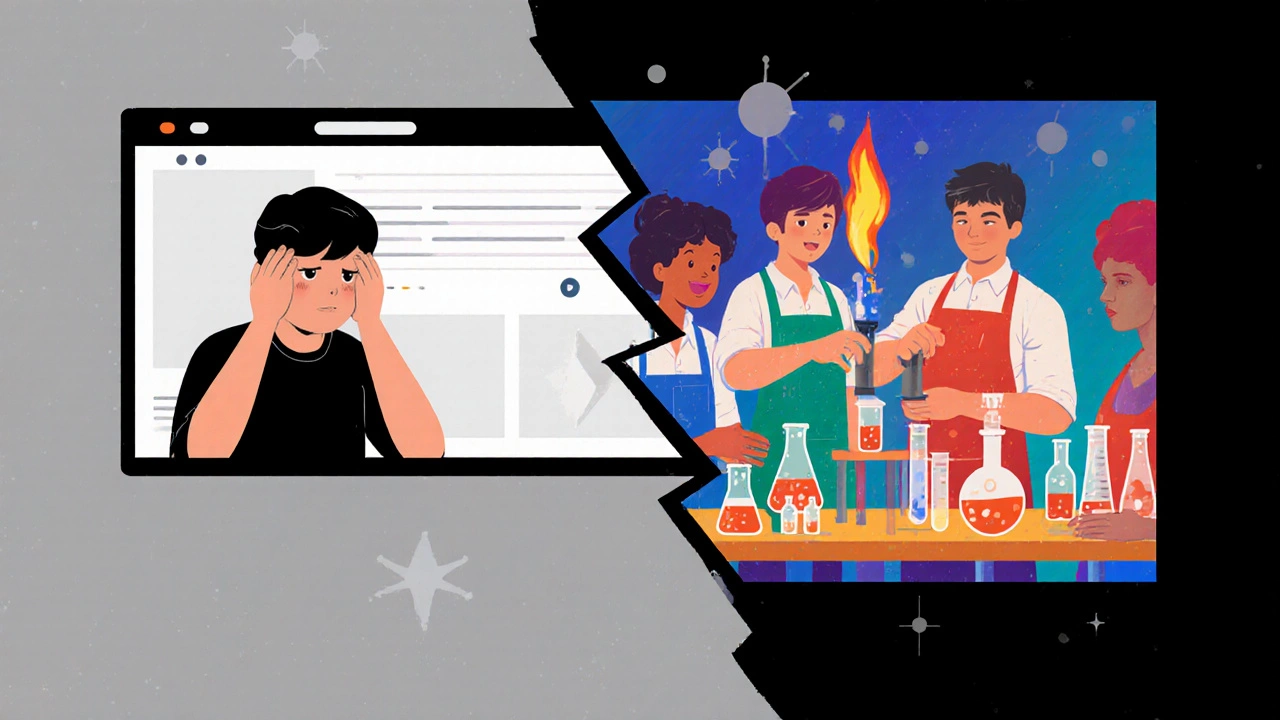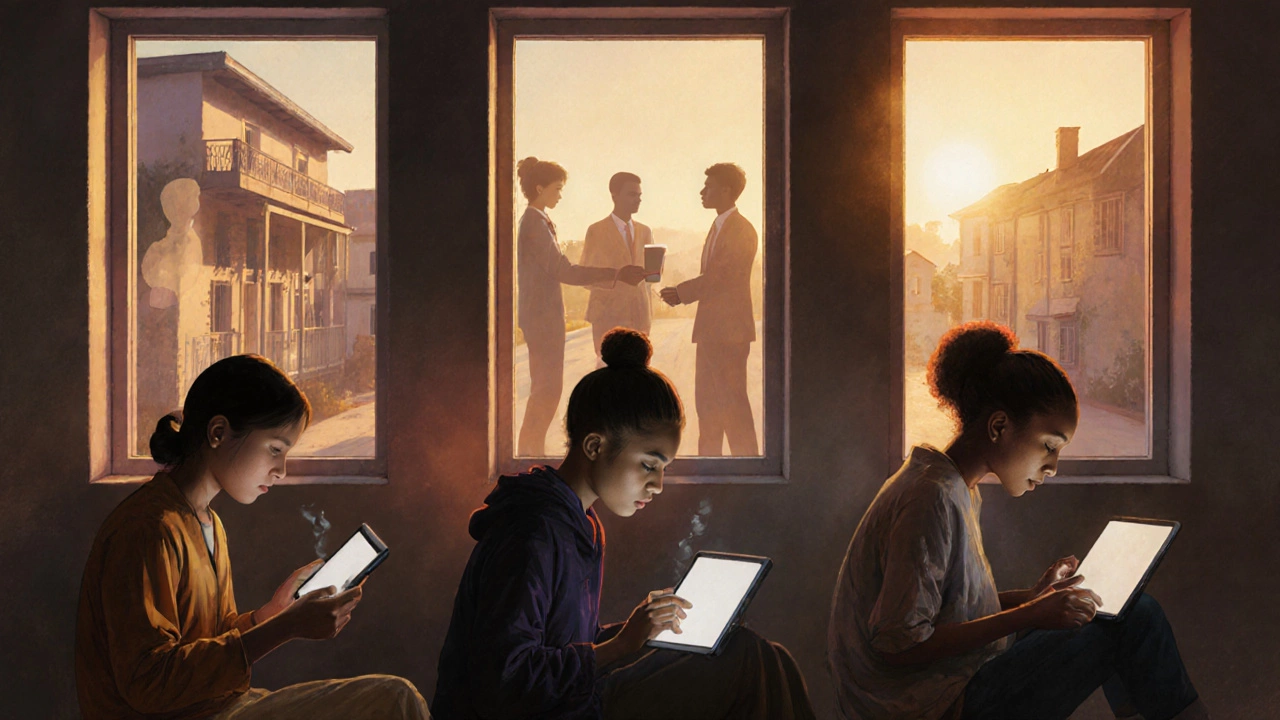Online learning promised freedom-learn anytime, anywhere, at your own pace. But for millions of students and professionals who’ve tried it, the reality is messier. Sure, you can watch lectures in pajamas, but you’re also fighting distractions, loneliness, and tech glitches that no one warns you about. eLearning isn’t broken-it’s just not the magic fix everyone sold it as.
You’re on your own, with no safety net
In a traditional classroom, if you don’t understand something, you raise your hand. In eLearning, you’re often left scrolling through forums or waiting hours for an email reply. Many platforms don’t offer live instructors. Even when they do, office hours are limited or buried in a menu. A 2024 study by the National Center for Education Statistics found that 68% of online learners felt isolated when struggling with course material. No one checks in. No one notices if you’ve gone silent for days. You’re responsible for your own momentum-and that’s a heavy burden when motivation dips.
Technology doesn’t always work
Imagine logging in for a final exam, only to find your video won’t load. Or your microphone cuts out during a group presentation. Or your laptop overheats because you’re running three tabs, a video player, and a note-taking app at once. These aren’t rare glitches-they’re daily frustrations. Not everyone has a reliable internet connection, a modern device, or a quiet space to study. In rural areas or low-income households, poor bandwidth means buffering lectures, dropped Zoom calls, and missed deadlines. You can’t study if the platform crashes every time you click ‘Submit’.
Hands-on learning? Good luck.
Some skills just can’t be taught through a screen. Trying to learn surgery, welding, chemistry lab techniques, or even basic carpentry via video is like learning to ride a bike by watching YouTube. Simulation tools help, but they’re not the same as feeling resistance, smelling chemicals, or making a real mistake with real consequences. Medical schools still require in-person clinical rotations. Engineering programs need physical labs. Even creative fields like music or theater rely on live feedback and group dynamics. eLearning can explain theory, but it can’t replace muscle memory or tactile experience.
It’s harder to stay focused
Your bedroom isn’t a classroom. It’s where you sleep, snack, scroll TikTok, and answer texts. There’s no physical separation between work and rest. A 2023 survey by Educause found that 74% of online learners admitted to multitasking during lectures-checking messages, browsing social media, or even watching TV in the background. Without the structure of a scheduled class and the presence of peers, focus crumbles. Procrastination isn’t just a habit-it’s built into the system. You tell yourself you’ll watch the lecture later. Then later becomes never.

Networking dies in a digital vacuum
College isn’t just about grades. It’s about connections. The friend you study with becomes a colleague. The professor you impress might write your recommendation. The club you join leads to an internship. eLearning platforms rarely foster these relationships. Discussion boards feel sterile. Group projects often turn into one person doing all the work. Most learners never meet their classmates. LinkedIn profiles don’t replace coffee chats or hallway conversations. For career-focused learners, this isolation can hurt long-term growth. You graduate with a certificate-but no network.
Assessments don’t always measure real skill
Online quizzes and automated grading are convenient-but they’re shallow. Can a multiple-choice test really tell if you can think critically, communicate clearly, or solve complex problems? Probably not. Many courses rely on timed exams you take alone, with no proctoring or open-book rules that make cheating easy. Some platforms use AI to detect plagiarism, but they can’t assess original thought. You might pass a course without ever applying what you learned in real life. Employers know this. That’s why many still prefer degrees from brick-and-mortar schools, even for entry-level roles.
Not all content is created equal
Anyone can upload a course. That means quality varies wildly. Some platforms host expert-led programs with peer-reviewed materials. Others are filled with poorly recorded videos, outdated information, and vague assignments. There’s no universal standard for what makes a good online course. You might pay $500 for a certificate that no employer recognizes. Or worse-you spend weeks on a course only to realize the instructor has no real industry experience. Without accreditation or reviews from trusted sources, it’s hard to tell what’s worth your time.

It doesn’t suit everyone’s learning style
Some people thrive with structure, group energy, and face-to-face feedback. Others need visual aids, hands-on demos, or verbal explanations. eLearning often assumes one-size-fits-all: video + reading + quiz. That doesn’t work for learners with ADHD, dyslexia, or anxiety. Accessibility features like captions or screen-reader support are often an afterthought. Even when they’re available, they’re clunky or incomplete. If your brain learns best by talking things out or moving around, sitting in front of a screen for hours is exhausting-not empowering.
Completion rates tell the real story
Less than 10% of people who enroll in MOOCs (Massive Open Online Courses) finish them. That’s not because they’re lazy. It’s because the system isn’t designed for completion. No one holds you accountable. No one notices if you fall behind. No penalty exists for quitting. Compare that to a traditional semester-attendance is tracked, deadlines are enforced, and professors follow up. eLearning removes those external pressures. Without them, even motivated learners struggle to stay on track.
What’s the alternative?
Hybrid models are starting to work better. Some universities combine online lectures with weekly in-person labs or discussion groups. Bootcamps now offer mentorship sessions and peer accountability groups. Corporate training programs pair eLearning with team projects and live feedback. These aren’t perfect-but they’re closer to real learning. If you’re choosing an online course, look for one that includes: live sessions, peer interaction, hands-on projects, and direct access to instructors. Avoid anything that’s just videos and PDFs.
eLearning has its place. But pretending it’s better than traditional learning is misleading. It’s different. And for many, it’s harder. The key isn’t to reject it-it’s to know its limits. Use it wisely. Supplement it. Don’t let convenience become a trap.
Is eLearning cheaper than traditional education?
Sometimes, but not always. While many online courses cost less than college tuition, hidden expenses add up: reliable internet, a good laptop, software licenses, and proctoring fees. You also lose income if you quit a job to study full-time. Some free courses are high-quality, but certificates from them often don’t carry weight with employers. So while the upfront price might be lower, the total cost-time, effort, and opportunity-can be higher.
Can eLearning help you get a job?
It can, but only if you pair it with proof of skill. A certificate alone won’t get you hired. Employers want portfolios, projects, internships, and references. If you’re taking an online course, build something real-a website, a report, a video, a code repository-and show it off. Some tech companies now hire based on GitHub profiles or coding challenges, not degrees. But for most fields, especially outside tech, employers still value accredited programs and in-person experience.
Are online degrees respected by employers?
It depends on the school and the field. Degrees from accredited universities like Arizona State, University of Illinois, or Southern New Hampshire University are widely accepted. But degrees from unknown or for-profit online-only schools raise red flags. Employers check accreditation status and whether the program required in-person components. If your degree says "online only" and has no recognizable name, it might not open doors-even if you passed every test.
Why do people quit online courses?
The top reasons: lack of accountability, no social support, poor course design, and feeling overwhelmed. Many sign up with high hopes but don’t realize how much self-discipline it takes. Without deadlines, group pressure, or regular feedback, motivation fades fast. Courses that include weekly check-ins, peer groups, or live coaching have much higher completion rates.
Is eLearning bad for mental health?
It can be. Constant screen time, isolation, and the pressure to self-manage can increase anxiety and burnout. A 2025 study in the Journal of Educational Psychology found that students in fully online programs reported 30% higher levels of stress than those in hybrid or in-person programs. The lack of physical movement, natural light, and human interaction takes a toll. Taking breaks, getting outside, and connecting with others-even virtually-isn’t optional. It’s necessary.
